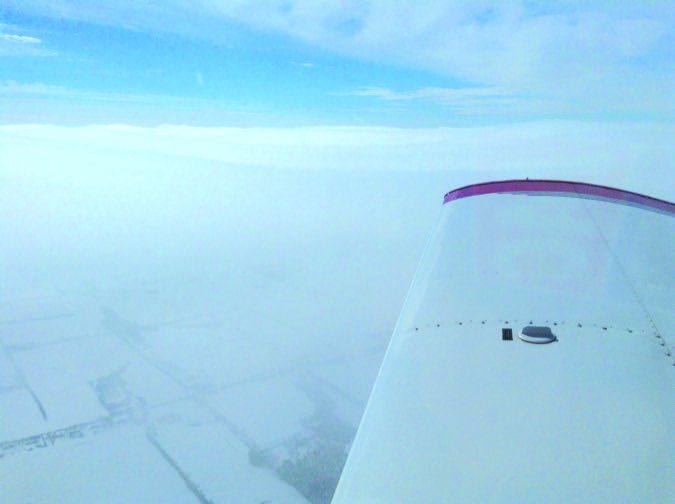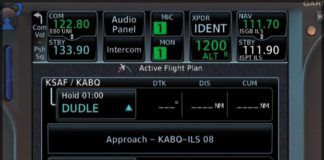For some, the shoulder seasons mean ideal flying weather – crisp spring and fall mornings with great visibility, often under a stable ceiling. These conditions offer fantastic climb performance, and the lack of bugs splattered all over the windshield is a plus. Morning fog, too, is pretty to look at, although it sure puts a damper on early-bird departures.

Fog often gets worse before it gets better, which can cause frustrating delays for any aircraft, especially the four-seaters. And that is where it stands on a lovely Monday morning at dawn in Rutherfordton, North Carolina, where your meticulously planned 6:02 am departure is a no-go. You’re flying westbound for home and a bunch of meetings at the office, or at least wishing you were. Any time now, the sun will burn off most of the fog and you can easily get to 8000 feet, overflying the mist lacing the Blue Ridge Mountains.
Just when you think you see a patch of sun on KFQD’s north-south runway at 7:02 a.m., the fog thickens and the reported weather says, in part: “M1/4SM FG VV001 11/11.” You’re now well behind schedule and, while you know it’s best to wait ‘til the visibility improves to a mile with a better defined ceiling, you find yourself considering the low-vis/no-vis takeoff to make the morning’s second meeting: How ‘bout it?
Check the Regs
This question has all sorts of implications for you, the Part 91 PIC flying a well-equipped four-seater, complete with GPS and autopilot. As far as this part of the regs go, you can take off legally … but you’ll want to check carefully for obstacle clearance options.
You quickly recall that key reg allowing for what’s colloquially known as a zero-zero takeoff. (In reality, there’s usually some visibility and just a thin layer of fog of less than 200 feet in many cases, but the same issues apply.) So if all works perfectly and you’re on top of the fog mere seconds after your takeoff roll, you’re good to go, right?
Under 91.175, “Takeoff and landing under IFR,” Part 121 and 135 operations must use “a takeoff obstacle clearance or avoidance procedure…” So you’re OK to go—if you aren’t going to fly a graphically charted standard instrument departure with stated minimums. You also wonder why the text of this reg has the “landing” part before “takeoff,” but no time to think now, you want to get going!
Rutherford County has published notes for takeoff and departure, and they’re nearly identical for Runways 1 and 19. Runway 1 (you’d prefer to head out northbound) calls for “standard” (one mile visibility for singles and twins) “with a climb of 220 feet per NM to 2600 feet, or 2900-3 in visual conditions.” You’re confident of climbing well above this to clear obstacles.
The notes following for Runway 1 make you slow down for a sec: “Rwy 1, Climbing right turn heading 130 to intercept 200 course to FRT NDB. ADF required.” Where the heck is FRT, and what’s an NDB again? You pop the fix into your flight planner and see that it takes you in the opposite direction of your desired heading. You decide that since obstacle clearance is legally up to you on departure, you can certainly get a clearance that takes you straight out.
The What Ifs
Now you start thinking about whether this is within your comfort level. With the vis less than 1/4 mile, you’ll be on instruments from the time you start to roll. Maintaining centerline will likely require one eye outside and the other on the heading indicator. All the while, you must quickly scan engine gauges and airspeed as you accelerate. When was the last time you did something like this? Not sure; maybe during training?
You have a flight director that can be set for a climb rate under instruments, but what is that going to be when rotating? Can’t recall. Also, your takeoff technique might be different on a foggy takeoff. You might consider a short-field technique, holding the brakes before moving, to ensure the engine’s OK to go at takeoff power. What was the last time you did this? Can’t recall.
Then there’s the obvious risk of hitting something on the runway. You wonder how an abort would turn out if a couple of deer popped out. What if you’re speeding down the pavement and spot a big tree branch just waiting to poke your tires? You’d have a split sec to decide on an emergency stop. In your mind, things are looking as murky as that mist hanging around out there.
A more subtle hazard is disorientation during acceleration and takeoff in IMC. Somatogravic illusion (acceleration effects on the inner ear) can cause the feeling of pitching up or down (the opposite of what the aircraft is actually doing) during a takeoff roll and rotation on instruments.
What about loss of power on takeoff? You’re going to land straight ahead, visual or not. Maybe you could come back on approach if there’s enough power, such as in a capable twin or a single still delivering some power. Should you get caught in such a dilemma and make an emergency call to get back to the field, you’ll get one shot at flying an RNAV approach to either runway—significantly below mins. Yeah, it’s legal…

Now What?
The only upside to leaving now is, well, you get to salvage the rest of your workday. It’s a quarter to 8 a.m., and you realize that in all the time you took deliberating a takeoff, the reported weather went to a mile visibility and a 400-foot ceiling—a hair over approach minimums. It’s not too thick and it’s slowly rising.
You forgot to amend your departure time, but your flight plan might still be there. Since you have to call Flight Service for a clearance anyway, you check with them and explain your changes. You’re still in the system, so you copy a clearance with 15 minutes to depart and regroup with the startup checklist.
Now you can taxi out to Runway 1 and take a final assessment. You can clearly see the end of the 5000-foot runway, so vis is about a mile and you can look outside as usual for takeoff. Rotating about a third of the way down the runway, you look up and see fog obscuring some of your view, so you go right back to your instrument scan and keep best rate of climb at 100 knots, making 700 feet per minute. By the time you get to 2600 feet, the top of what’s now a broken fog layer has dropped below you and you’re cleared on course in the sun.
Ultimately, it didn’t matter because you took long enough to consider everything and the weather improved. Plus, you’re no longer in such a hurry, which means you can enjoy that great morning view on the way home. (f)Civil airport takeoff minimums. This paragraph applies to persons operating an aircraft under part 121, 125, 129, or 135 of this chapter.
(f)Civil airport takeoff minimums. This paragraph applies to persons operating an aircraft under part 121, 125, 129, or 135 of this chapter.




